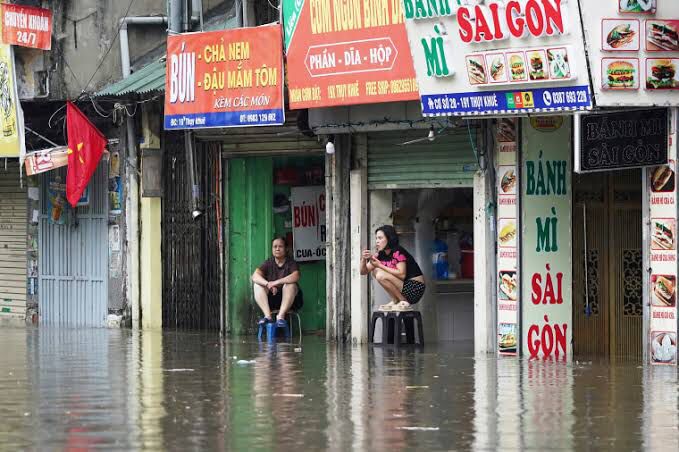
Typhoon Kajiki leaves homes submerged and trees uprooted across Vietnam’s north central coast. Image credit: NBC News
(The Post News) – Typhoon Kajiki made landfall on Vietnam’s north-central coast on Monday, leaving widespread destruction in its wake. Nearly 7,000 homes were damaged, 18,000 trees were toppled, and thousands of hectares of rice fields were submerged, according to Vietnamese authorities.
Three people have died in the storm. Among them is a 90-year-old man whose house collapsed in heavy rain and a man in Nghe An province who was electrocuted while trying to secure his roof. The typhoon also brought down 331 electricity poles, causing widespread blackouts across several provinces.
Heavy rainfall continued into Tuesday morning, flooding streets in Hanoi. Cars were seen submerged up to their roofs, and the city’s largest lake overflowed, disrupting daily life. Several villages in Bac Ninh province were cut off due to rising waters, leaving residents stranded and in need of assistance.
Air travel was heavily affected as two airports—one in Thanh Hoa and another in Quang Binh province—remained closed after flights were grounded on Monday. Authorities announced plans to evacuate 600,000 residents and 152,000 homes across Thanh Hoa, Quang Tri, and Danang provinces. To support evacuation and rescue efforts, the government mobilized 16,500 soldiers and 107,000 paramilitary personnel.
Vietnam’s coastline along the South China Sea is prone to powerful storms that often trigger deadly floods and landslides. Kajiki was projected to be stronger than last year’s Typhoon Yagi, which killed 300 people and caused $2.4 billion in damage.
After making landfall, Kajiki weakened into a tropical depression as it moved inland toward Laos on Tuesday morning. However, the national weather agency warned that some northern areas could receive up to 150 millimeters (six inches) of rain in just six hours, creating a high risk of flash floods and landslides.
The storm also affected neighboring countries. In China, Hainan province downgraded its emergency response after residents in the resort city of Sanya took shelter on Sunday as trees and buildings were damaged. In Thailand, officials warned residents in foothills and low-lying areas near rivers to prepare for possible flash floods and landslides as heavy rain continues through Wednesday.
Authorities continue to monitor the situation closely, urging residents to stay vigilant and follow evacuation orders. Relief teams are on standby to respond to emergencies, ensuring safety for those most at risk from Kajiki’s deadly impacts.



